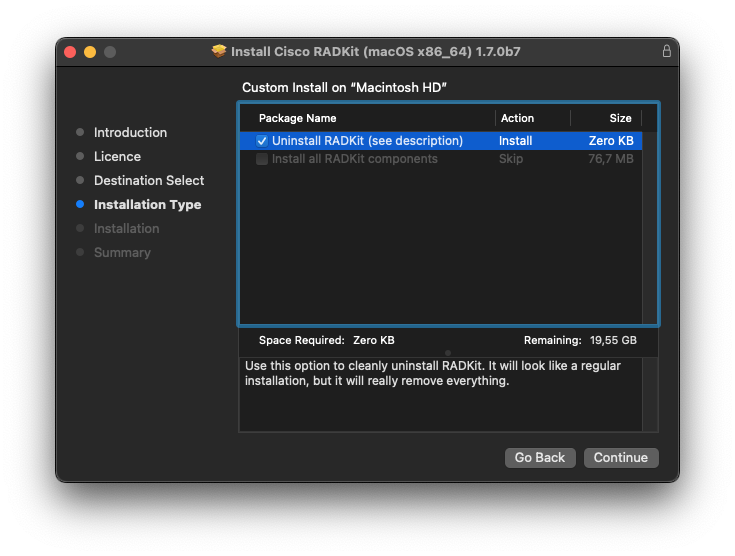macOS installer
Installing RADKit
Please visit the downloads area and get the latest RADKit installer for your macOS system. Note that both Intel and Silicon architectures are supported (make sure that you select the correct installer, as RADKit for Intel will not run on Silicon, even if Rosetta is installed). The installer is code-signed by Cisco (see Code signing for details).
The RADKit installer sets up a complete, dedicated Python environment with the appropriate interpreter version and all required packages. It is not possible to add packages such as PyATS or other libraries in this environment.
Warning
Please do not alter the Python environment deployed by the installer in any way. The
application is signed and all component versions are tested for compatibility. Installing new
packages or upgrading existing ones could break your RADKit installation. In order to
add packages and/or do advanced scripting, please use a pip-based installation
method instead.
Starting RADKit
The different RADKit components can be started either from the Applications folder, or through the CLI from a Terminal window:
radkit-clientradkit-controlradkit-interactiveradkit-medic-guiradkit-network-consoleradkit-serviceradkit-service-gui
Note
When started from the Applications folder shortcut, the RADKit Client runs inside a Terminal window, so if you do not see the Client window open up, look for a Terminal window that may be hidden in the background.
Directory layout
The installer only supports a machine-wide installation.
The RADKit Python environment and all packages are unpacked under
/Library/Cisco/RADKit(this path cannot be changed).The application shortcuts are created under
/Applications/RADKit*.app.The CLI shortcuts are created under
/usr/local/bin.The data files will be stored under each user’s
$HOME/.radkitby default (where$HOMEis the user’s home directory).
Note that although there is a single machine-wide RADKit installation, every user gets their own separate RADKit data directory.
Updating RADKit
To update, simply download the newest installer, run it on top of the current installation and follow the instructions.
Uninstalling RADKit
Re-run the RADKit installer (either the version that you installed, or a more recent one) and select the Uninstall RADKit option. The other options will be deselected and greyed out, and once you hit Continue, the installer will uninstall RADKit and terminate.
